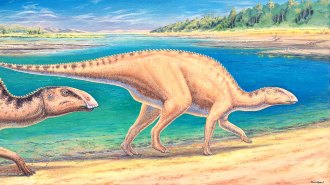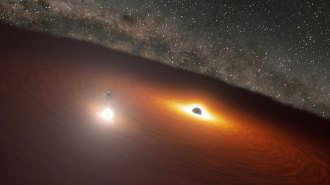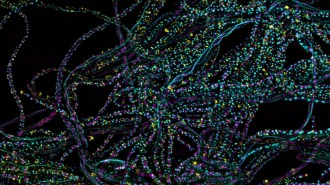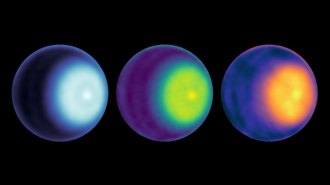News
-
 Life
LifeNew fossils from Patagonia may rewrite the history of duck-billed dinosaurs
New findings are adding a wrinkle to researchers’ understanding of how duck-billed dinosaurs conquered the Cretaceous world.
By Jake Buehler -
 Physics
PhysicsPhysicists split bits of sound using quantum mechanics
New experiments put phonons — the tiniest bits of sound — into quantum mechanical superpositions and show they are as weird as other quantum entities.
-
 Climate
ClimateWhy is the North Atlantic breaking heat records?
Record-breaking sea-surface temperatures off the coast of Africa may affect the 2023 hurricane season. What’s fueling the unusual heat is unclear.
By Sid Perkins -
 Astronomy
AstronomyA supermassive black hole orbiting a bigger one revealed itself with a flash
A supermassive black hole binary system has puzzled astronomers for decades. Now they’ve finally seen direct signals from the smaller of the two.
-
 Chemistry
ChemistryOne photon is all it takes to kick off photosynthesis
A single particle of light is the spark that begins the process of turning light to chemical energy in photosynthetic bacteria, a new study confirms.
-
 Astronomy
AstronomyJupiter-sized planets are very rare around the least massive stars
A six-year search of 200 nearby low-mass red dwarf stars found no Jupiter-like planets, boosting the standard theory for how such planets form.
By Ken Croswell -
 Animals
AnimalsCamouflaging wheat with a wheat smell could be a new approach to pest control
Wheat fields coated in wheat germ oil confuse the noses of mice, reducing seed loss by more than 60 percent, a new study finds.
-
 Animals
AnimalsBowhead whales may have a cancer-defying superpower: DNA repair
Bowhead whale cells repair damaged DNA exceptionally well, an ability that could prevent cancer and help the marine mammals live for centuries
By Meghan Rosen -
 Space
SpaceA cyclone has been spotted swirling over Uranus’ north pole for the first time
Voyager 2 hinted at a cyclone at Uranus’ south pole. Now Earth-based observations give the first direct evidence of a storm at the ice giant’s north pole.
-
 Archaeology
ArchaeologyAn old perfume bottle reveals what some ancient Romans smelled like
Chemical analyses reveal that an unopened flask of perfume from 2,000 years ago contained patchouli, a common ingredient in modern perfumes.
-
 Climate
ClimateWildfire smoke is blanketing the U.S. East Coast. It won’t be the last time
Climate change will continue to exacerbate fire risk across the world’s boreal forests, making events like the dangerous smoke over the U.S. East Coast more common.
-
 Environment
EnvironmentRising groundwater threatens to spread toxic pollution on U.S. coastlines
Sea level rise is pushing groundwater into shallower layers of earth, threatening to spread hazardous chemicals from contaminated soils.
By Nikk Ogasa